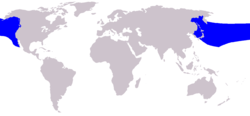Top Qs
Timeline
Chat
Perspective
Baird's beaked whale
Species of mammals From Wikipedia, the free encyclopedia
Remove ads
Baird's beaked whale (Berardius bairdii), also known as the northern giant bottlenose whale, North Pacific bottlenose whale, giant four-toothed whale, northern four-toothed whale and North Pacific four-toothed whale, is a species of whale from the genus Berardius. Baird's and Arnoux's beaked whales are so similar that researchers have debated whether or not they are simply two populations of the same species. However, genetic evidence and their wide geographical separation has led them to be classified as separate. Baird's beaked whale is the second largest living species of toothed whale after the sperm whale.
Remove ads
Taxonomy
Baird's beaked whales were first described in 1883 by American zoologist Leonhard Stejneger based on a skull from a specimen that had been found stranded on the eastern shore of Bering Island the previous fall. The species was named after Spencer Fullerton Baird, the then Secretary of the Smithsonian.[3] A few months after Stejneger's description was published, Swedish zoologist August Wilhelm Malm published a description of a new species in the Beradius genus, Beradius vegae, based on a portion of a skull found on Bering Island in 1879. Beradius vegae was later determined to be a junior synonym of Beradius bairdii.[4][5]
Remove ads
Description
Summarize
Perspective

The species reaches lengths of about 11.9 metres (39 ft) for males and 12.8 metres (42 ft) for females.[6] The longest confirmed specimen was 13 m (43 ft) in length and the heaviest was 14 tonnes (15 short tons).[7]
The snout, called a beak, is elongated and lacks all teeth except for one or two sets in the lower mandible, which are called "battle teeth" for their use in intra-species conflict. Individuals often bear scars from such confrontations. The complex social structure, including fission-fusion societies with groups of individuals that maintain stable associations over many years, suggests that the species is capable of social learning and the transmission of sophisticated behavioral patterns.[8] Baird's beaked whales live in schools of up to 100 individuals that form a tight group at the surface, possibly as a defense mechanism against orcas.[9]
The age of sexual maturity is thought to be 10–15 years for females and 6–11 years for males. Young baird's beaked whales remain with their mothers until they are 6–9 years old. The testes continue to grow until the whales are 30–40 years old, and only these older males are likely to participate in reproduction. The oldest in a study of baird's beaked whales were 54 years for females and 84 years for males, respectively.[10][9][8]
Remove ads
Distribution
The species occurs primarily in the North Pacific Ocean, where it is a deep-water cetacean, often frequenting depths between 1,000 and 3,000 m (3,280 and 9,840 ft) in its search for prey.
In the northwestern part of its range, sightings have been documented off of Hokkaido, Japan, Sakhalin and Kamchatka, as well as in the Sea of Okhotsk, the Bering Sea and the Aleutian Islands. In the more eastern and southern reaches of their distribution, they have been seen from southern Alaska and down the U.S. West Coast to San Diego and northern Baja California.
Whaling
Historically, at least 4,000 Baird's beaked whales have been hunted, primarily by Japan, but also by Russia, Canada, and the United States. Commercial whalers in Japan still hunt Baird’s beaked whales.[11]
References
Wikiwand - on
Seamless Wikipedia browsing. On steroids.
Remove ads




